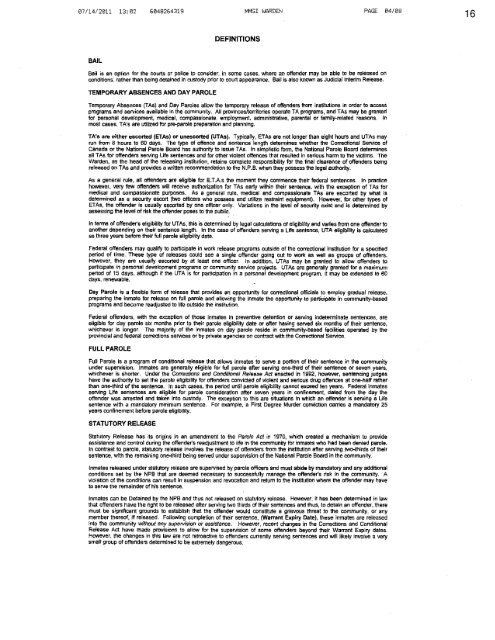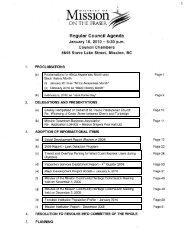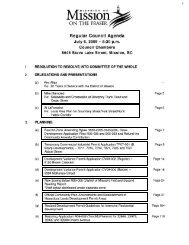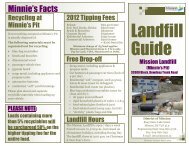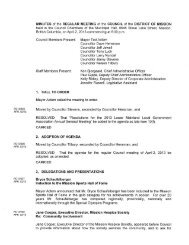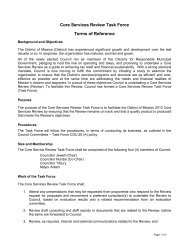August 8, 2011 - District of Mission
August 8, 2011 - District of Mission
August 8, 2011 - District of Mission
Create successful ePaper yourself
Turn your PDF publications into a flip-book with our unique Google optimized e-Paper software.
07/14/<strong>2011</strong> 13:02 6048264319 MMSI WARDEN PAGE 04/0816DEFINITIONSBAILBail is an option for the courts or police to consider, in some cases, where an <strong>of</strong>fender may be able to be released onconditions, rather than being detained in custody prior to court appearance. Bail is also known as Judicial Interim Release,TEMPORARY ABSENCES AND DAY PAROLETemporary Absences (TAs) and Day Paroles allow the temporary release <strong>of</strong> <strong>of</strong>fenders from institutions in order to accessprograms and services available in the community. All provinces/territories operate TA programs, and TAs may be grantedfor personal development, medical, compassionate, employment, administrative, parental or family-related reasons. Inmost cases, TA's are utilized for pre-parole preparation and planning.TA's are either escorted (ETAs) or unescorted (UTAs). Typically, ETAs are not longer than eight hours and UTAs mayrun from 8 hours to 60 days. The type <strong>of</strong> <strong>of</strong>fence and sentence length determines whether the Correctional Service <strong>of</strong>Canada or the National Parole Board has authority to issue TAs. In simplistic form, the National Parole Board determinesall TAs for <strong>of</strong>fenders serving Life sentences and for other violent <strong>of</strong>fences that resulted in serious harm to the victims. TheWarden, as the head <strong>of</strong> the releasing institution, retains complete responsibility for the final clearance <strong>of</strong> <strong>of</strong>fenders beingreleased on TAs and provides a written recommendation to the N.P.B. when they possess the legal authority.As a general rule, all <strong>of</strong>fenders are eligible for E.TA.s the moment they commence their federal sentences. In practicehowever, very few <strong>of</strong>fenders will receive authorization for TAs early within their Sentence, with the exception <strong>of</strong> TAs formedical and compassionate purposes. As a general rule, medical and compassionate TAs are escorted by what isdetermined as a security escort (two <strong>of</strong>ficers who possess and utilize restraint equipment). However, for other types <strong>of</strong>ETAs, the <strong>of</strong>fender is usually escorted by one <strong>of</strong>ficer only. Variations in the level <strong>of</strong> security exist and is determined byassessing the level <strong>of</strong> risk the <strong>of</strong>fender poses to the public. .In terms <strong>of</strong> <strong>of</strong>fenders eligibility for UTAs, this is determined by legal calculations <strong>of</strong> eligibility and varies from one <strong>of</strong>fender toanother depending on their sentence length. In the case <strong>of</strong> <strong>of</strong>fenders serving a Life sentence, UTA eligibility is calculatedas three years before their full parole eligibility date.Federal <strong>of</strong>fenders may qualify to participate in work release programs outside <strong>of</strong> the correctional institution for a specifiedperiod <strong>of</strong> time. These type <strong>of</strong> releases could see a single <strong>of</strong>fender going out to work as well as groups <strong>of</strong> <strong>of</strong>fenders.However, they are usually escorted by at least one <strong>of</strong>ficer. In addition, UTAs may be granted to allow <strong>of</strong>fenders toparticipate in personal development programs or community service projects. UTAs are generally granted for a maximumperiod <strong>of</strong> 15 days. although if the UTA is for participation in a persona/ development program, it may be extended to 80days, renewable.Day Parole is a flexible form <strong>of</strong> release that provides an opportunity for correctional <strong>of</strong>ficials to employ gradual release,preparing the inmate for release on full parole and allowing the inmate the opportunity to participate in community-basedprograms and become readjusted to life outside the institution.Federal <strong>of</strong>fenders, with the exception <strong>of</strong> those inmates in preventive detention or serving indeterminate sentences, areeligible for day parole six months prior. to their parole eligibility date or after having served six months <strong>of</strong> their sentence,whichever is longer. The majority <strong>of</strong> the inmates on day parole reside in community-based facilities operated by theprovincial and federal corrections services or by private agencies on contract with the Correctional Service.FULL PAROLEFull Parole is a program <strong>of</strong> conditional release that allows inmates to serve a portion <strong>of</strong> their sentence in the Communityunder supervision. Inmates are generally eligible for full parole after serving one-third <strong>of</strong> their sentence or seven years,whichever is shorter. Under the Corrections and Conditional Release Act enacted in 1992, however, sentencing judgeshave the authority to set the parole eligibility for <strong>of</strong>fenders convicted <strong>of</strong> violent and serious drug <strong>of</strong>fences at one-half ratherthan one-third <strong>of</strong> the sentence. In such cases, the period until parole eligibility cannot exceed ten years. Federal inmatesserving Life sentences are eligible for parole consideration after seven years in confinement, dated from the day the<strong>of</strong>fender was arrested and taken into custody. The exception to this are situations in which an <strong>of</strong>fender is serving a Lifesentence with a mandatory minimum sentence. For example, a First Degree Murder conviction carries a mandatory 25years confinement before parole eligibility,STATUTORY RELEASEStatutory Release has its origins in an amendment to the Parole Act in 1970, which created a mechanism to provideassistance and control during the <strong>of</strong>fender's readjustment to life in the community for inmates who had been denied parole.In contrast to parole, statutory release involves the release <strong>of</strong> <strong>of</strong>fenders from the institution after serving two-thirds <strong>of</strong> theirsentence, with the remaining one-third being served under supervision <strong>of</strong> the National Parole Board in the community.Inmates released under statutory release are supervised by parole Officers and must abide by mandatory and any additionalconditions set by the NP13 that are deemed necessary to successfully manage the <strong>of</strong>fender's risk in the community. Aviolation <strong>of</strong> the conditions can result in suspension and revocation and return to the institution where the <strong>of</strong>fender may haveto serve the remainder <strong>of</strong> his sentence.Inmates can be Detained by the NPB and thus not released on statutory release. However, it has been determined in lawthat <strong>of</strong>fenders have the right to be released after serving two thirds <strong>of</strong> their sentences and thus, to detain an <strong>of</strong>fender, theremust be significant grounds to establish that the <strong>of</strong>fender would constitute a grievous threat to the community, or anymember there<strong>of</strong>, if released. Following completion <strong>of</strong> their sentence, (Warrant Expiry Date), these inmates are releasedinto the community without any supervision or assistance. However, recent changes in the Corrections and ConditionalRelease Act have made provisions to allow for the supervision <strong>of</strong> some <strong>of</strong>fenders beyond their Warrant Expiry dates.However, the changes in this law are not retroactive to <strong>of</strong>fenders currently serving sentences and will likely involve a verysmall group <strong>of</strong> <strong>of</strong>fenders determined to be extremely dangerous.


